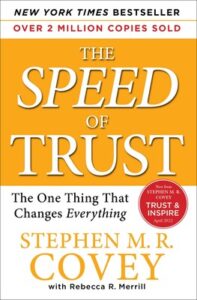Behavior #13: Extend Trust, page 222.
Summary: Behavior #13 – Extend Trust
- Demonstrate a propensity to trust.
- Extend trust abundantly to those who have earned your trust.
- Extend trust conditionally to those who are earning your trust.
- Learn how to appropriately extend trust to others based on the situation, risk, and credibility (character and competence) of the people involved, but have a propensity to trust.
- Don’t withhold trust because there is risk involved.
Behavior #13 – Extend Trust
- Behavior #13 – Extend Trust – is different from the rest of the behaviors. It’s about shifting from “trust” as a noun to “trust” as a verb.
- While the other behaviors help you become a more trusted person or manager, this behavior will help you become a more trusting leader.
- Not only does it build trust, it leverages trust.
- It creates reciprocity; when you trust other people, other people tend to trust you in return.
- Ironically, extending trust is one of the best ways to create trust when it’s not there.
- The transference of trust, also known as a “trust bridge,” is when both parties independently have trust in the same individual, and that individual expresses his trust in each party to the other, the two parties are then able to transfer their trust to the other.
- Don’t be gullible.
- Don’t extend trust indiscriminately or unwisely.
What Happens When You Extend Trust
- Extend Trust is based on the principles of empowerment, reciprocity, and a fundamental belief that most people are capable of being trusted, want to be trusted, and will run with trust when it is extended to them.
- The opposite of Extend Trust is to withhold trust, which creates an enormous cost everywhere, especially in organizations.
- Why does such a low percentage of employees have trust in their senior leaders? I contend that a principal reason is that senior leaders don’t trust their people and this distrust gets reciprocated.
- Thus, senior leaders are actually complicit in helping produce their employees’ distrust. It becomes a vicious downward cycle: People tend not to trust people who don’t trust them.
- The counterfeit of Extend Trust takes two forms:
- First, extending “false trust,” or giving people the responsibility, but not the authority or resources to get a task done.
- Second, extending “fake trust,” or acting like you trust someone when you really don’t. This takes the form of “snoopervising,” hovering over, or “big brothering” the person.
A Powerful Motivator
- Nothing motivates or inspires people like having trust extended to them. And when it is, people don’t need to be managed or supervised; they manage themselves.
- By extending trust, you:
- Empower people
- Leverage your leadership
- Create a high-trust culture that brings out the best in people
Trust Tips
- To Extend Trust takes strength in Integrity, Intent, Capabilities, and Results.
- If you’re on the left side of the curve, you’re likely not extending enough trust or not extending it effectively. You may want to focus on increasing courage (Integrity), enhancing your propensity to trust (Intent), or improving your ability to clarify expectations, hold others accountable, or Extend Smart Trust in more actionable ways (Capabilities).
- If you’re on the right side of the curve, you’re probably extending too much trust and getting burned.
Improving Your Ability to Extend Trust
- Think about a relationship where someone doesn’t trust you. Ask yourself, could this person’s lack of trust in me, at least, in part, be a reflection on my own lack of trust in him or her?
- If you’re caught in a downward spiral, try to reverse it.
- Start behaving in ways that extend trust, and notice the results.
- On a scale of one to ten, determine where you think you are in terms of extending trust to others.
- Imagine the result of moving your performance point to the left (extending less trust)…and then to the right (extending more trust).
- Identify one to two steps to improve your ability to Extend (or not overextend) Trust.



